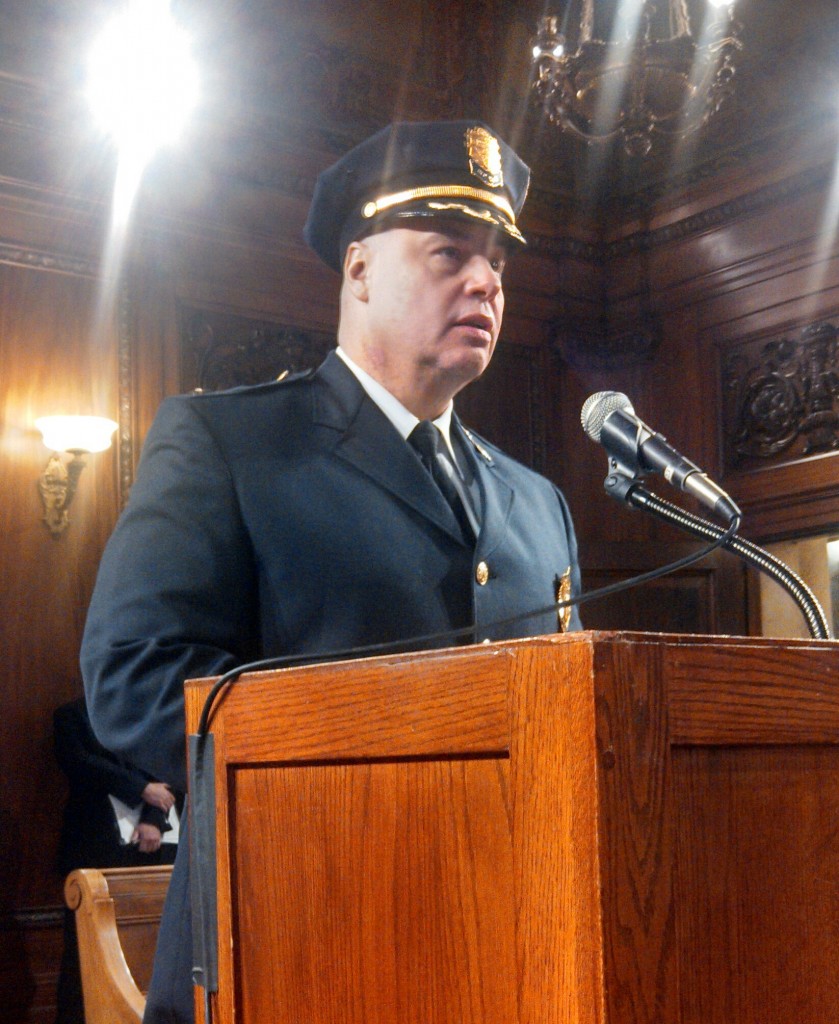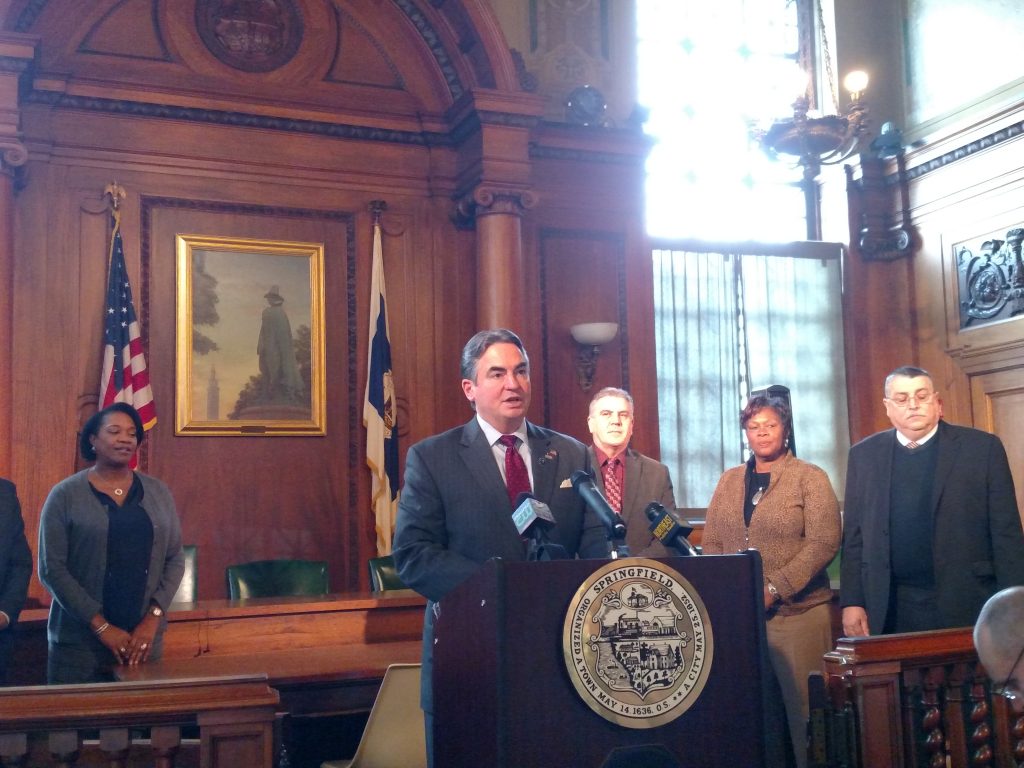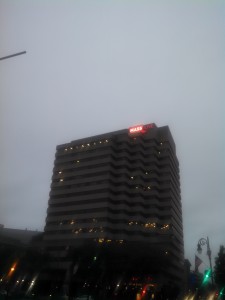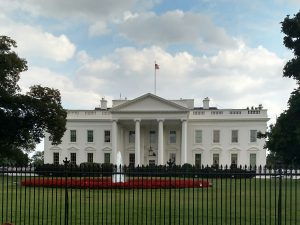Analysis: Press Changes Affect Springfield, Starting with the Man in the Media…
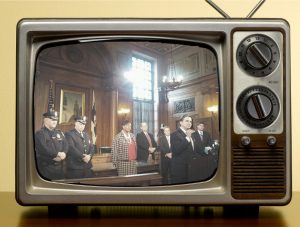
Sarno was once a made-for-TV mayor. But are press changes changing the effectiveness of his style? (created from Google images and WMassP&I photo)
Media remains an essential part of the landscape within which politicians and government officials operate. This is true on almost all levels except, perhaps, very small towns—where it is possible to get to know everybody—and some small cities that behave as such. Springfield is not one of those places and some events in the past week show how the traditional relationships to media has shifted.
Springfield pols and officials, particularly those that towed the party line, could expect generally good coverage, provided no fire or natural disaster knocked them out of the lead story. Lately, that has not been happening. Indeed, Police Commissioner John Barbieri’s lament about bad publicity and Mayor Domenic Sarno’s email praising Donald Trump reflect changing local media-government relationships.
It is an overstatement to suggest that no accountability existed until recently. The problem was some outlets, including print and television, were sometimes cheerleading for friends rather than consistently offering sober assessments of local events. Moreover Pearl Street’s not-too-distant past hardly escaped tough coverage from local media.

On Springfield’s front lines at one time. (via Facebook/official)
But often it was smaller outlets taking on 36 Court Street. Only when controversies brewed out of control, some skeptics would argue, did Valley mainstream media pile on. After all, it was The Valley Advocate, not The Republican’s forebears, that led reporting into Michael Albano’s chaotic and catastrophic mayoralty.
Now The Republican and its online alter-ego/frenemy Masslive are digging up dirt on Pearl Street and the mayor’s office.
Barbieri claimed at a budget meeting last week the bad press is hurting morale. It almost felt like a plea for gentler coverage. Though not very persuasive, the press, especially “if it bleeds, it leads” television is unlikely to behave differently. In another time, such a comment might prompt local editors to urge reporters to ease up. The imperative of attracting readers’ eyeballs all but foreclose that.
Installed in a ceremony that almost seemed like Springfield’s answer to the queen’s coronation, media expectations were understandably high. Yet the scrambling of police frequencies, allegedly to keep sensitive info out of wrongdoers’ ears, raised eyebrows. The city ultimately helped qualifying news outlets obtain descrambling equipment, but by establishing criteria eligibility, its actions could become constitutionally suspect.
In fact, recent bad press is really a problem in Barbieri’s own shop. Somebody is talking and leaking to Stephanie Barry and Dan Glaun at The Republican and Masslive respectively. In the past, perhaps Pearl Street denizens felt they could not trust mainstream media with leaks.
Still, Barbieri and the cops’ changing media relationship is not a major problem yet. From a reporter’s perspective, Sgt. John Delaney, the department’s public information officer, remains accessible. Perhaps more importantly, the police don’t need the press the way politicians do.
At one time, Sarno was a big beneficiary of modern media’s need to mill content. Yet, consistent protests and more confrontational, if thoroughly peaceful, actions are drawing attention, too. The White House’s outreach to Sarno and his adulatory response were a welcome respite.
Virtually all of Springfield’s modern municipal electeds have thrived on media. One sage Springfield political veteran observed Springfield Public Access bolstered then-councilor Robert Markel vote totals as residents could see his grasp on issues.
As late as 1989, WWLP and WGGB did lengthy stories about individual councilors and their careers. Now councilors are lucky to get the back of their heads into a shot panning the council chamber inevitably included in stories on Council meetings.
Even as television tiptoed away from political analysis and the newspaper began to thin, Sarno, however, stayed relevant, on camera and in print. Personable and laser-focused on his talking points—“BOND RATING!”—he engages the press quite well. The tornado proved this perfectly.
Since becoming mayor there began a certain aloofness which the past year of bad headlines has exacerbated. After his 2008 inauguration, Maureen Turner documented in The Valley Advocate that the once freewheeling, accessible councilor had become difficult to pin down as mayor. Obviously, his added duties were part of that, but the change was conspicuous.
Nevertheless, between a “be everywhere” approach and select boosterism from some outlets, Sarno remained popular as mayor—even politically bulletproof—for years.
Thus, Masslive’s questions for Police Department stories likely jolted the mayor’s office. Unable to ignore the website like he could an alternative weekly or a wannabe Politico-on-the-Connecticut blog, Sarno had to respond, sometimes uncomfortably. Then the usually friendly Republican followed, breaking stories as the Bigda dam burst.
Arguably, it began even earlier. Once feted as a sign of downtown’s “renewal,” New England Public Radio’s arrival also meant another curious and enterprising newsroom was within walking distance of City Hall. NEPR—and its regional public radio competitor WAMC—closely followed the sleepy 2015 mayoral race and interviewed the candidates.
WMassP&I editor-in-chief Matt Szafranski is a frequent guest on NEPR’s Short List.
What about the White House email exchange? The real question is why release the email at all? The conversation is only preliminary. There is no news other than that the White House contacted Sarno—perhaps because of Fox News exposure—and the mayor replied with a big wet kiss for Trump.
Sarno might be hoping to have an in with the administration—although Trump’s erstwhile failure to even appoint all his nominees let along get them confirmed undercuts that. Counterintuitively, this could be a press strategy for Sarno.
It is an easy story to pitch to content-hungry media outlets. Sarno, a Democrat, gets to appear bigger than politics and reach out to someone his constituents largely detest for the sake of God and city. It also mirrors the mayor’s rightward lurch. Moreover, Sarno gets a reprieve from Bigda headlines, a resurgent city council and protesters.
Notably, Sarno has largely avoided one means to reach the people that his new BFFL in the White House discovered long ago: social media. Sources have said former aides had to beg Sarno to put the city on Facebook and Twitter, which Communications Director Marian Sullivan maintains now. Nonetheless, it remains an underutilized resource.
Three years before he faces voters again, Sarno’s need to drum up this Trump story—and the flag one before that—remains odd. These stories will not tamp down protesters’ demands or councilors’ assertion of power. Bringing Trump into the mix will only galvanize a veto-overriding supermajority among councilors facing reelection this year.
Media’s transformation and struggles have sent ripples through Springfield politics, too. Given how he has responded, one might wonder from where Sarno is getting advice to adapt.
